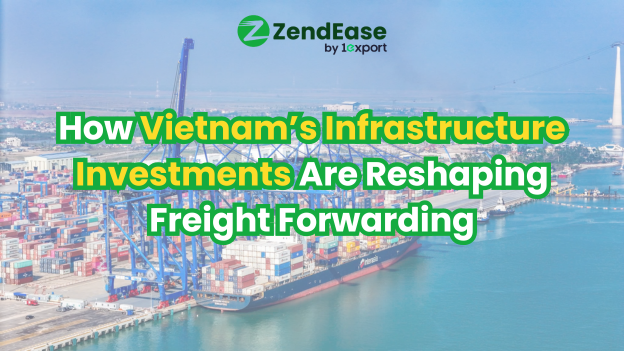How Vietnam’s Infrastructure Investments Are Reshaping Freight Forwarding
by Ly Nguyen on Oct 30, 2025

Vietnam is entering a new logistics era. From upgraded seaports to high-speed expressways and multimodal corridors, billions of dollars in infrastructure investments are transforming how goods move — both within the country and across borders.
For freight forwarders and shippers, these upgrades are more than just construction projects. They’re changing trade routes, delivery speeds, and even the geography of Vietnam’s supply chain network.
A Wave of Strategic Investments
Vietnam’s government has set an ambitious goal: to become a top 40 logistics performer globally by 2030. To achieve that, infrastructure spending has surged across key sectors:
1. Modern Seaports and Maritime Corridors
- Vietnam’s latest seaport master plan (Decision 442/QĐ-TTg, 2024) expands capacity to 1.5 billion tons of cargo annually by 2030.
- Deep-water ports like Lạch Huyện (Hải Phòng) and Cái Mép – Thị Vải (Bà Rịa – Vũng Tàu) are now able to handle larger vessels directly, cutting transshipment dependence on Singapore or Hong Kong.
- This means fewer delays, lower shipping costs, and more direct routes for both imports and exports.
2. Multimodal Connectivity and Rail Revival
- Rail freight is making a comeback. With targets to move nearly 9 million tons of cargo by 2030, Vietnam is investing in dry ports and integrated logistics zones such as Vĩnh Phúc ICD SuperPort — a key link between northern industrial zones, ports, and border crossings with China.
- This rail–road–sea integration is reshaping how freight forwarders plan routes, especially for time-sensitive cargo moving between ASEAN and China.
3. Expressways and Inland Logistics Expansion
- Vietnam now has more than 1,900 km of expressways, with plans to reach 5,000 km by 2030.
- New routes like the North–South Expressway and regional connectors (e.g., Long Thành – Dầu Giây, Trung Lương – Mỹ Thuận) are reducing inland transit times and opening logistics hubs in previously underdeveloped areas.
What This Means for Freight Forwarding
Shorter Transit Times
New expressways and port access roads are cutting travel time by up to 30% in some corridors. For exporters in Bình Dương or Bắc Ninh, faster access to ports means lower trucking costs and more reliable delivery schedules.
Diversified Routes, Less Congestion
More multimodal options mean shippers aren’t tied to just one mode or port. Freight can now shift between road, rail, and sea depending on demand, weather, or capacity — a flexibility that didn’t exist a decade ago.
Regional Integration Across ASEAN
Vietnam’s infrastructure push isn’t just domestic. Projects like the Lào Cai – Hà Nội – Hải Phòng corridor and the East–West Economic Corridor (connecting Vietnam, Laos, Thailand, and Myanmar) strengthen Vietnam’s position as a regional logistics hub — linking mainland Southeast Asia with maritime trade routes.
More Competitive Logistics Costs
According to Vietnam’s Ministry of Industry and Trade, logistics currently accounts for about 16–18% of GDP, higher than the regional average. Infrastructure improvements are expected to reduce that ratio significantly by 2030, improving margins and competitiveness for local exporters.
A Shifting Freight Landscape
These investments are also changing where logistics value is created. As industrial zones expand beyond HCMC and Hanoi to provinces like Bình Phước, Quảng Ninh, and Thanh Hóa, freight forwarders are adjusting their networks to stay closer to production sites.
Digitization is also accelerating alongside infrastructure. Smart ports, customs automation, and electronic documentation are enabling faster clearance — making Vietnam’s freight ecosystem more transparent and predictable.
The Road Ahead
Vietnam’s infrastructure transformation is still underway, but its direction is clear — a more connected, competitive, and resilient logistics system.
For freight forwarders and shippers, this means opportunities to rethink routes, optimize costs, and tap into new regional flows. For Vietnam, it marks the next stage in becoming a true logistics powerhouse within ASEAN.
In Short
Vietnam’s infrastructure investments aren’t just improving roads and ports — they are redrawing the map of how trade moves through Asia.
At ZendEase, we explore how regional trade, logistics, and digital innovation are shaping the way businesses move goods across borders. Follow us for more insights on Vietnam’s fast-evolving freight landscape and ASEAN supply chain trends.